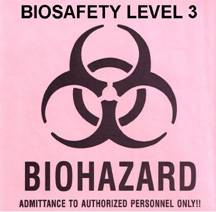 Last year, the U.S. Department of Health and Human Services awarded more than $1 billion in bioterrorism preparedness grants nationwide to beef up states’ public health systems and hospital plans. The Nebraska Department of Health and Human Services System received $9,722,687, part of which was allocated to its Nebraska Public Health Laboratory (NPHL) at UNMC for expansion and state-of-the-art equipment.
Last year, the U.S. Department of Health and Human Services awarded more than $1 billion in bioterrorism preparedness grants nationwide to beef up states’ public health systems and hospital plans. The Nebraska Department of Health and Human Services System received $9,722,687, part of which was allocated to its Nebraska Public Health Laboratory (NPHL) at UNMC for expansion and state-of-the-art equipment.
The funds will allow staff to improve the laboratory’s capabilities to identify infectious diseases, including the identification of bacteria that could be used as bioterrorist agents.
Ready to respond
“Having a BSL-3 (Bio-safety Level) laboratory in our state greatly improves our readiness to respond to a public health threat, whether it be a naturally occurring outbreak, such as West Nile Fever and SARS, or an intentional bioterrorist attack,” said Anne Mardis, M.D., medical epidemiologist, Nebraska Health and Human Services System. “A bioterrorist attack may not be recognized immediately, so it is imperative that we are ready for all outbreaks.”
Dr. Mardis said epidemiologists at the Nebraska State Health and Human Services System can work closely with the NPHL to plan and coordinate needed laboratory testing without having to rely on a distant laboratory with other priorities.
BSL-3 lab provides for testing, research
UNMC has operated the BSL-3 lab since 1988, testing for the rabies virus and conducting research on highly infectious diseases, but the facility had become outdated. Technologists now work with bacteria that cause tuberculosis, anthrax, tularemia, influenza, Severe Acute Respiratory Syndrome, and other infectious agents.
Rating BSL labs
Labs are rated according to their bio-safety levels, which establish the development and implementation of administrative policies, work practices, facility design, and safety equipment to prevent transmission of biologic agents to workers, other persons, and the environment. Levels are designated in ascending order, by degree of protection provided to staff and the environment.
The following are examples of various BSL labs:
- BSL-1 labs — high school or college laboratories;
- BSL-2 labs — clinical hospital laboratories;
- BSL-3 labs — specialized labs that contain potentially deadly bacteria;
- BSL-4 labs — contain dangerous and exotic agents that pose a high individual risk of aerosol-transmitted laboratory infections and life-threatening disease.
“Our BSL-3 lab is an isolated lab with increased security and restricted access as regulated by the Federal Bureau of Investigation and Department of Justice,” said Tony Sambol, coordinator of special pathogens bio-security laboratory section of the Nebraska Department of Health and Human Services System’s NPHL. “Background checks are done on staff that work in the lab.”
Upgrading the lab
Sambol said upgrades will include installation of High Efficiency Particulate Air (HEPA) systems that filter and purify air in the laboratory to protect lab workers, as well as automated specimen-processing equipment that reduces the time it takes to get test results by 75 percent.
Along with upgrade of the BSL-3 comes increased security requirements for staff, facilities, and information and technology systems, as well as more stringent procedures for agent inventory and accountability, shipping/transfer and receipt of select agents, accidental incident and injury policies, emergency response plans, and policies that address breaches in security. Staff are required to be well-trained and equipped, Sambol said.
“Public health labs have been ignored a long time in the United States,” he said. “The threat of bioterror events have showed the need to enhance the public health system and the money that has been spent in the last year has resulted in great improvement of our capabilities.”